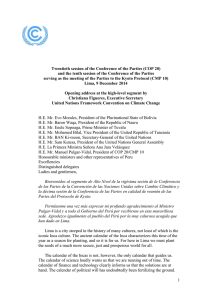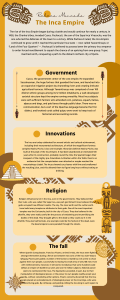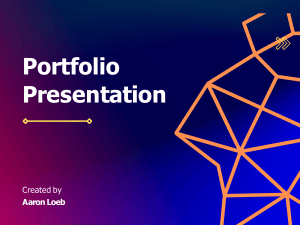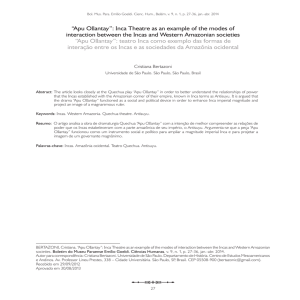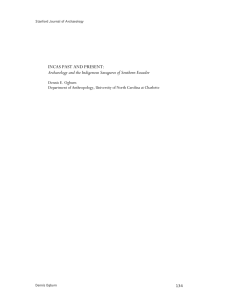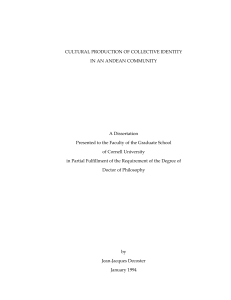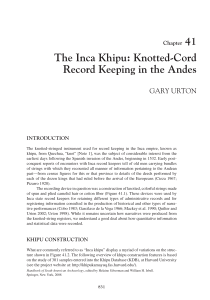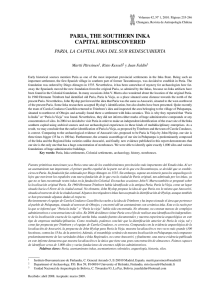Syllabus
Anuncio
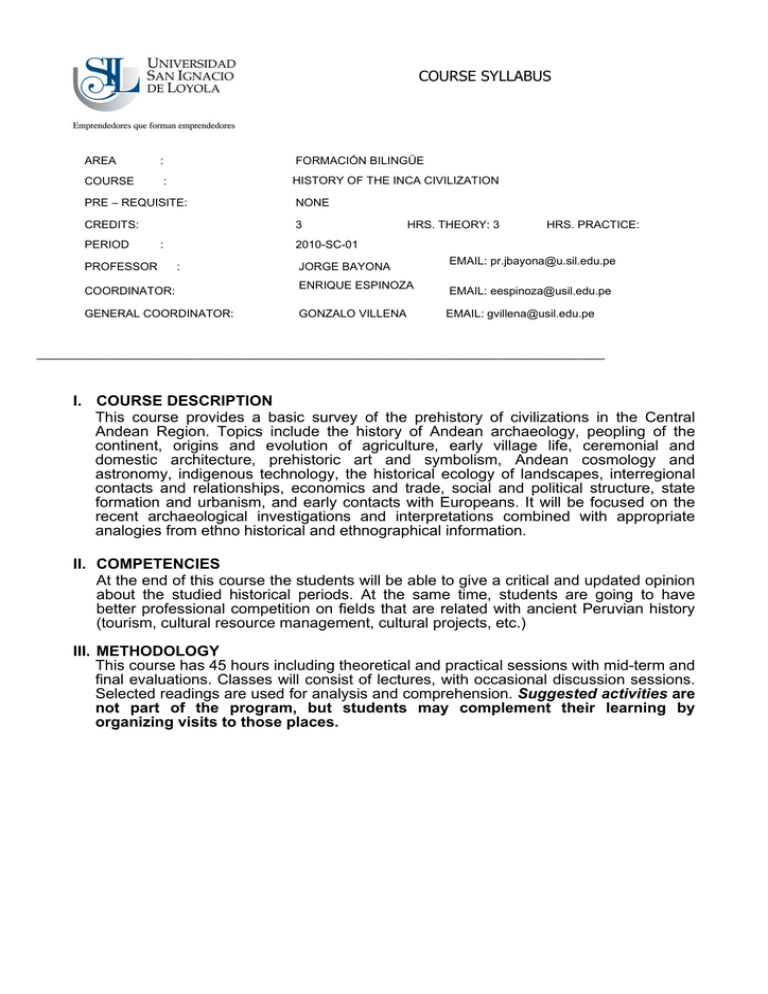
COURSE SYLLABUS AREA : FORMACIÓN BILINGÜE COURSE : HISTORY OF THE INCA CIVILIZATION PRE – REQUISITE: NONE CREDITS: 3 PERIOD : PROFESSOR HRS. THEORY: 3 HRS. PRACTICE: 2010-SC-01 : COORDINATOR: GENERAL COORDINATOR: JORGE BAYONA ENRIQUE ESPINOZA GONZALO VILLENA EMAIL: [email protected] EMAIL: [email protected] EMAIL: [email protected] ________________________________________________________________________________________ I. COURSE DESCRIPTION This course provides a basic survey of the prehistory of civilizations in the Central Andean Region. Topics include the history of Andean archaeology, peopling of the continent, origins and evolution of agriculture, early village life, ceremonial and domestic architecture, prehistoric art and symbolism, Andean cosmology and astronomy, indigenous technology, the historical ecology of landscapes, interregional contacts and relationships, economics and trade, social and political structure, state formation and urbanism, and early contacts with Europeans. It will be focused on the recent archaeological investigations and interpretations combined with appropriate analogies from ethno historical and ethnographical information. II. COMPETENCIES At the end of this course the students will be able to give a critical and updated opinion about the studied historical periods. At the same time, students are going to have better professional competition on fields that are related with ancient Peruvian history (tourism, cultural resource management, cultural projects, etc.) III. METHODOLOGY This course has 45 hours including theoretical and practical sessions with mid-term and final evaluations. Classes will consist of lectures, with occasional discussion sessions. Selected readings are used for analysis and comprehension. Suggested activities are not part of the program, but students may complement their learning by organizing visits to those places. IV. SCHEDULE AND LEARNING STRATEGIES Unit I: INTRODUCTION W H 1 3 CONTENTS STRATEGIES AND LEARNING PROCEDURE Introduction to Course: The field of History. The Ancient Recognize the importance of time and Peruvian History: problems and approaches. Concepts: space in the Andean thoughts culture, period, etc. The concept of "Andean" ACTIVITIES Readings and slide presentations. Unit II: THE ANDEAN AREA AND CHRONOLOGY W H CONTENTS 1 6 Andean area: geographical and framework. Andean chronology. Prehispanic Andean Society STRATEGIES AND LEARNING ACTIVITIES PROCEDURE cultural Peruvian Learn the processes of adaptation to Readings and slide The Roots of environment presentations. Unit III: PRE INCA CULTURES W H CONTENTS 2 2 2 2 2 2 2 3 STRATEGIES AND LEARNING ACTIVITIES PROCEDURE Initial Period: the rise of complex society. From Caral to Value the religious structures and FIRST ASSIGNMENT Chavín. understand their functions Chavin as synthesis of the Formative Period. The consolidation of identities in the Andes: Paracas, Nazca, Moche, Cajamarca, Recuay, etc. Wari and the Middle Horizon Period. The climatic break Analyze the Wari phenomenon in the Readings and slide of the VI century and its effects on Andean societies. Andes. Acknowledge and value the presentations New political expressions and integrational processes different Andean identities. The Late Intermediate Period: Political and ideological Visit to Pikillacta diversity before the Incas. The Chimú and North Coast (suggested activity) Kingdoms, Pachacamac, Chincha, etc The sources: knotted strings, histories, Spanish and Know and value the different colonial Readings and slide indigenous documents: chronicles, visitas. Oral tradition sources to understand the Inca history presentations and archaeological resources The Roots of the Inka Empire. Inkas came to Cusco. Understand the socio political diversity SECOND The Cusco ethnics and first Inkas on Urubamba valley ASSIGNMENT Unit IV: INKA EMPIRE W H 3 2 3 2 CONTENTS STRATEGIES AND LEARNING ACTIVITIES PROCEDURE Pachacutec and the formation of the Inka Empire. Identify the existing formation about the Readings and slide Political management: reciprocity. Hereditary rights. Inca Empire presentations Tupac Yupanqui. Conquest and the political organization Cusco city tour: Pachacutec Palace, Plaza de Armas. (suggested activity) MID TERM EXAMS Unit V: INKA EMPIRE S H 3 3 CONTENTS STRATEGIES AND LEARNING ACTIVITIES PROCEDURE Inca Political economy: reciprocity and redistribution. Recognize the economical and political Readings and slide Mitta, minqa, ayni. Ecology and agriculture. foundations of Inca Empire presentations State administrative and productive enclaves. Inca Political economy: agriculture and cultivation systems. Livestock and Andean economy. Administration of the Empire: provincial centers, roads, and way stations 3 2 Visit to Sacred Valley Visit to Pisac, Moray and Maras (suggested activity) Inca Statecraft: weaving, ceramics and metal Recognize the economical and political THIRD ASSIGNMENT. production. Architecture of power: design, engineering, foundation of the Inca Empire Visit to Inca Museum and aesthetics: (suggested activity) Unit VI: INKA CULTURE W H CONTENTS STRATEGIES AND LEARNING PROCEDURE Recognize the social foundations of the Inca Empire ACTIVITIES 4 3 Inca society: the family and the common rituals. 4 3 Inca religión: ritual calendar, ceques, and astronomy. Distinguish the ideological issues of Inca Readings and slide The cult of ancestor worship. Pilgrimage and sacred Empires presentations mountains Visit to the Temple of the Sun. (suggested activity) Unit VII: SPANISH CONQUEST W H CONTENTS Readings and slide presentations STRATEGIES AND LEARNING PROCEDURE ACTIVITIES 4 3 Spanish conquest of the Incas FOURTH ASSIGNMENT 5 7 The Inka legacy in the contemporary Andes Readings and slide presentations 5 V. 2 FINAL EXAM EVALUATION The evaluation will be ongoing and will take in consideration the issues established in the competences and in the use of those competencies by each teacher. The dates for QUIZZES are referential for some courses due to the fact that some teacher may change them for oral work or presentations, in projects, case analysis, or debates. Furthermore, TASKS may be considered as homework, class work or written reports through Power Point presentations. At the end of the program, teacher will hand out a record with grades including the grades in the following issues: • • • • 20% - Participation in class (homework, reports, oral participation, and attitude in class) 10% - Average 1 10% - Average 2 30% - Ongoing evaluation (evaluations, exams, quizzes, written work, research, projects, and presentations) 15% - Average 1 15% - Average 2 25% - Mid-term exam 25% - Final Exam 1. 2. Percentage for the final score of the course N° Scheme 1 Ongoing Evaluation % percentage 30% 2 Class Participation 20% 3 Mid Term Exam 25% 4 Final Exam 25% Percentage for the Ongoing Evaluation (evaluations, exams, quizzes, written work, research, projects, and presentations) and Participation in Class (homework, reports, oral participation, and attitude in class) Evaluation N° Detailed percentage (%) Week Ongoing Evaluation 30% 1 50% 2 2 50% 4 Participation in Class 20% 1 50% 2 2 50% 4 VI. BIBLIOGRAPHY Bawden, Garth 1996 Burger, Richard 1993 Bonavía, Duccio 1991 Dollfus, Oliver 1981 Kaulicke, Peter 1994 Keating, Richard 1988 Lumbreras, Luis G. 1969 1981 1989 1993 Leon Canales, Elmo 2007 Makowski, Krszystof (Comp.) 2001, 2002 Moseley, Michael 1992 Murra, John 1975 Pease, Franklin 1978 Ravines, Roger (Ed.) 1970 Rostworowski, María 1992 1988 1977 Troll, Carl 1980 Varios autores 1999 Williams L., Carlos 1980 The Moche. Blackwel Publishers Inc. Emergencia de la Civilización en los Andes. UNMSM, Lima. Perú, hombre e historia. De los orígenes al siglo XVI. EDUBANCO, Lima. El reto del espacio andino. IEP, Lima. Los orígenes de la civilización andina. En: Historia general del Perú, Tomo I. Edición dirigida por J. A. Del Busto, Lima. Peruvian Prehistory. . Cambridge University Press. Antiguo Perú. De los pueblos, las culturas y las artes. Moncloa-Campodónico Editores, Lima Arqueología de la América Andina. Editorial Milla Batres, Lima. Chavín de Huántar en el nacimiento de la civilización andina. INDEA, Lima. Chavín de Huántar. Excavaciones en la Galería de las Ofrendas. Verlag Philipp von Zabern. Mainz am Rhein. Orígenes Humanos en los Andes del Perú. Universidad San Martín de Porres. Escuela Profesional de Turismo y Hotelería. Dioses del Antiguo Perú, 2 tomos. Banco de Crédito del Perú, Lima. The Incas and their ancestros. The Archaeology of Peru. Thames and Hudson Formaciones económicas y políticas del mundo andino. IEP, Lima. Del Tahuantinsuyo a la Historia del Perú. IEP, Lima. Cien años de arqueología en el Perú. IEP, Lima. Pachacamac y el Señor de los Milagros. IEP, Lima. Historia del Tahuantinsuyo. IEP, Lima. Etnia y sociedad. Costa peruana prehispánica. IEP, Lima. Las culturas superiores andinas y el medio geográfico. Allpanchis Phuturinqa. Vol. XIV, No. 15. Instituto de Pastoral Andina, Cusco. Culturas Prehispánicas. Colección de fascículos. Empresa editora El Comercio y Universidad Particular Ricardo Palma. Lima. Arquitectura y urbanismo en el antiguo Perú. En: Colección Historia del Perú. Tomo VIII: Perú republicano y procesos e instituciones. Editorial Juan Mejía Baca, Lima.
